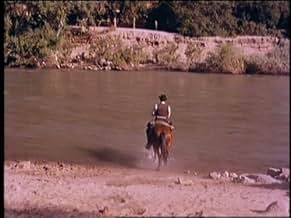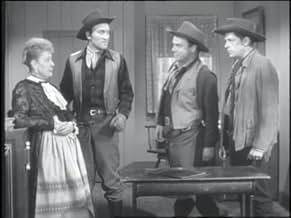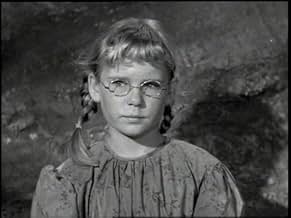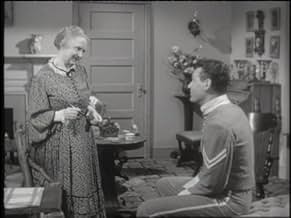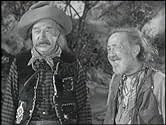CALIFICACIÓN DE IMDb
7.7/10
3.1 k
TU CALIFICACIÓN
Las aventuras del héroe enmascarado y su compañero Nativo Americano.Las aventuras del héroe enmascarado y su compañero Nativo Americano.Las aventuras del héroe enmascarado y su compañero Nativo Americano.
- Nominado a 2 premios Primetime Emmy
- 3 nominaciones en total
Explorar episodios
Opiniones destacadas
There was a time, from my childhood up until the mid-1980's, when shows such as the Lone Ranger and The Little Rascals filled week-day afternoon and Saturday morning TV slots. Old movies could be readily found on TV late at night and on Sunday afternoons. Ever since TV stations began filling every extra additional minute with infomercials and their own first-run productions and reality shows, as well as the beginning of the continuous news cycle, these old classics have not seen the light of day. This shows early years are on DVD, and if you ever get the chance to view the show, do understand that the TV show, at least at first, borrowed heavily from its radio roots.
Also note that some of the first episodes are very short - in some cases only 11 or 12 minutes long. That is because sometimes the sponsor would put two short serials in the same half hour slot. The time really belonged to the sponsor back in those days, and thus early TV schedules looked a lot like radio at first.
One of my favorite episodes was "The Silent Voice" towards the end of season two. The witness to a crime is a stroke victim who is completely paralyzed. The Lone Ranger comes up with a way for the woman to communicate by blinking in response to letters of the alphabet.
The other episode from this early part of the series that sticks out is one in which the wife in a husband/wife crime team betrays the husband and shoots him. He is presumed dead and taken to the undertaker's. The Lone Ranger discovers that the husband is not dead, and the husband makes a confession as to what is going on before he dies as he lies on a slab about to buried - alive. The Lone Ranger tricks the wife by claiming that her husband is still alive. That's what I liked about the Lone Ranger - it really could be very dark. There would always be the happy ending with the criminals rounded up and jailed, but that didn't mean that some good people didn't fall along the way or that something really creepy or cringe-worthy wasn't part of the plot.
Highly recommended if you ever get the chance.
Also note that some of the first episodes are very short - in some cases only 11 or 12 minutes long. That is because sometimes the sponsor would put two short serials in the same half hour slot. The time really belonged to the sponsor back in those days, and thus early TV schedules looked a lot like radio at first.
One of my favorite episodes was "The Silent Voice" towards the end of season two. The witness to a crime is a stroke victim who is completely paralyzed. The Lone Ranger comes up with a way for the woman to communicate by blinking in response to letters of the alphabet.
The other episode from this early part of the series that sticks out is one in which the wife in a husband/wife crime team betrays the husband and shoots him. He is presumed dead and taken to the undertaker's. The Lone Ranger discovers that the husband is not dead, and the husband makes a confession as to what is going on before he dies as he lies on a slab about to buried - alive. The Lone Ranger tricks the wife by claiming that her husband is still alive. That's what I liked about the Lone Ranger - it really could be very dark. There would always be the happy ending with the criminals rounded up and jailed, but that didn't mean that some good people didn't fall along the way or that something really creepy or cringe-worthy wasn't part of the plot.
Highly recommended if you ever get the chance.
Seriously, while I don't want to be unfair to John Hart, it's impossible for me to watch any of his episodes and not miss Clayton Moore, and I mean miss Clayton Moore badly. It's hard to believe that producer George Trendle really thought he could put anyone in the mask and the public wouldn't know the difference. And the difference was enormous. Clayton Moore played the Lone Ranger with great style and unquestionable sincerity. To me, Clayton Moore' Lone Ranger and William Boyd's Hopalong Cassidy were the best of the early television western heroes. They hold a special place in the hearts of many baby boomers, myself included.
The Lone Ranger appeared on the ABC network on September 15, 1949 in the first of a three part episode that told the history of the famous masked man of the West.
Along with William Boyd's Hopalong Cassidy TV series, which was first telecast on NBC on June 24, 1949, it was among the earliest TV western series. Hopalong Cassidy actually debuted in 1948, when Boyd syndicated his films to NBC. (In 1947, Boyd had bought to the rights to his Hoppy films.)
Fran Stiker and George W. Trendle created the Lone Ranger as a local radio program in 1933. It quickly went nationwide and was the cornerstone of the old Mutual Radio network. Ironically, Hopalong Cassidy was also a Mutual radio program.
When The Lone Ranger was brought to TV in 1949, many of the radio plays were adapted to the younger medium. As a consequence, many of the earliest episodes show their radio origins with the use of a narrator who links the different scenes together. The Lone Ranger was the biggest hit on the new ABC network in its early years.
The first three episodes told the the familiar story of how the Lone Ranger came to be, his connection to Tonto, and the origins of his prize horse Silver. Glenn Strange played the villain Butch Cavandish in these episodes.
The Lone Ranger was also one of the earliest shows to film mostly outdoors. Starting in 1956, the Wrather Company began filming the program in color.
The Cisco Kid, starring Duncan Renaldo and Leo Carrillo had been filmed in color since its first aired in 1950. Jack Wrather, however, was more concerned about the competition to his kid's show from the new adult westerns that had began to appear on TV.
When the Lone Ranger appeared, The New York Times critic Jack Gould ripped the show, as "just another Western, and not a notably good one at that." Gould considered the first three episodes manipulative, mostly because of the cliffhanger endings of the first two episodes. The New York Times writer accused everyone associated with the program of keeping children "emotionally hopped upped." As a result of his criticisms, the cliffhanger type endings were never used after the first two episodes. Gould, however, had been suffering from a misunderstanding. The show had never intended to be broadcast as a serial despite the serial background of its star Clayton Moore.
In 1952, B-film actor John Hart replaced Clayton Moore. Moore had threatened to quit after 1950. He was being paid only $500 an episode for his hit show, and wanted a substantial raise. Audiences rejected Hart in the role, and after 36 episodes Moore was back atop Silver.
The Lone Ranger was the first Western Hit on TV.
The series was filmed in both Utah and in California.
Along with William Boyd's Hopalong Cassidy TV series, which was first telecast on NBC on June 24, 1949, it was among the earliest TV western series. Hopalong Cassidy actually debuted in 1948, when Boyd syndicated his films to NBC. (In 1947, Boyd had bought to the rights to his Hoppy films.)
Fran Stiker and George W. Trendle created the Lone Ranger as a local radio program in 1933. It quickly went nationwide and was the cornerstone of the old Mutual Radio network. Ironically, Hopalong Cassidy was also a Mutual radio program.
When The Lone Ranger was brought to TV in 1949, many of the radio plays were adapted to the younger medium. As a consequence, many of the earliest episodes show their radio origins with the use of a narrator who links the different scenes together. The Lone Ranger was the biggest hit on the new ABC network in its early years.
The first three episodes told the the familiar story of how the Lone Ranger came to be, his connection to Tonto, and the origins of his prize horse Silver. Glenn Strange played the villain Butch Cavandish in these episodes.
The Lone Ranger was also one of the earliest shows to film mostly outdoors. Starting in 1956, the Wrather Company began filming the program in color.
The Cisco Kid, starring Duncan Renaldo and Leo Carrillo had been filmed in color since its first aired in 1950. Jack Wrather, however, was more concerned about the competition to his kid's show from the new adult westerns that had began to appear on TV.
When the Lone Ranger appeared, The New York Times critic Jack Gould ripped the show, as "just another Western, and not a notably good one at that." Gould considered the first three episodes manipulative, mostly because of the cliffhanger endings of the first two episodes. The New York Times writer accused everyone associated with the program of keeping children "emotionally hopped upped." As a result of his criticisms, the cliffhanger type endings were never used after the first two episodes. Gould, however, had been suffering from a misunderstanding. The show had never intended to be broadcast as a serial despite the serial background of its star Clayton Moore.
In 1952, B-film actor John Hart replaced Clayton Moore. Moore had threatened to quit after 1950. He was being paid only $500 an episode for his hit show, and wanted a substantial raise. Audiences rejected Hart in the role, and after 36 episodes Moore was back atop Silver.
The Lone Ranger was the first Western Hit on TV.
The series was filmed in both Utah and in California.
Looking back on `The Lone Ranger' TV series as an adult is a strange experience. Watching episodes through an adult's eyes alerted me to flaws I didn't notice when I was a kid: the acting was sometimes on the B-movie level. The stories tended to be repetitive and simplistic. The Native Americans were generally played by Caucasian or Hispanic or Italian-American actors. The `outdoor' exteriors in a lot of episodes were obviously indoor sets. But there is a spirit and an energy to the show that you can't deny.
Most of the credit for the show's success goes to its leads, Clayton Moore and Jay Silverheels. They became the Lone Ranger and Tonto, lived the roles as no other actors before or since. Moore, in particular, knew the Ranger was presented as a hero and an example to children, and from what I've heard, he tried his best to live up to that. He made the Ranger a fair and just man, someone who didn't judge, who gave people the benefit of the doubt, but acted correctly when the time was right. He used violence only as a last resort. He was a symbol of honor and integrity, the kind of person I wish I could be.
As for Tonto... It occurs to me nowadays how great an actor Jay Silverheels was. Critics of the show always want to use Tonto as the stereotypical ignorant savage, but you have to look at all the things Tonto does. Tonto tracks, takes care of the Ranger when he's wounded, spies out information - you can tell from the expressions on Silverheels' face that there's a lot more going on inside Tonto's head than he lets on. Don't let the broken English fool you!
The thing that really impresses me about `The Lone Ranger' now is how much of a partnership these two characters have. Tonto is not the Ranger's subordinate - they are friends, equals in their adventures. That, as much as any lesson taught in any episode, is what draws me back to the series after so many years: a tried and true friendship.
Oh, if only the Lone Ranger could ride again.
Most of the credit for the show's success goes to its leads, Clayton Moore and Jay Silverheels. They became the Lone Ranger and Tonto, lived the roles as no other actors before or since. Moore, in particular, knew the Ranger was presented as a hero and an example to children, and from what I've heard, he tried his best to live up to that. He made the Ranger a fair and just man, someone who didn't judge, who gave people the benefit of the doubt, but acted correctly when the time was right. He used violence only as a last resort. He was a symbol of honor and integrity, the kind of person I wish I could be.
As for Tonto... It occurs to me nowadays how great an actor Jay Silverheels was. Critics of the show always want to use Tonto as the stereotypical ignorant savage, but you have to look at all the things Tonto does. Tonto tracks, takes care of the Ranger when he's wounded, spies out information - you can tell from the expressions on Silverheels' face that there's a lot more going on inside Tonto's head than he lets on. Don't let the broken English fool you!
The thing that really impresses me about `The Lone Ranger' now is how much of a partnership these two characters have. Tonto is not the Ranger's subordinate - they are friends, equals in their adventures. That, as much as any lesson taught in any episode, is what draws me back to the series after so many years: a tried and true friendship.
Oh, if only the Lone Ranger could ride again.
Someone once defined what is the definition of AN INTELLECTUAL as being: "A person who can listen to "The William Tell Overture" without thinking of the LONE RANGER!" In this, we heartily concur! It surely would be a tall order to accomplish this, and one that Leopold Stokowski, Arturo Toscanini or .Leonard Bernstein would all find nigh well impossible to do.
And in this there is no disgrace. The Radio Series and the Television Series, along with some Movie Serials, Feature Films, Syndicated Newspaper Comic Strip and Comic Books, all did their part to make "the Masked Man of the Plains and his Faithful Indian companion, Tonto" a deeply seeded element of our collective psyche and of our literary folklore.
As with most legends, it all started gradually, first with a series of Radio Plays, written for local use in Detroit over Radio Station WXYZ. The Creator was one George W. Trendle and the Principal Writer on the Series was Mr. Trendle's brother-in-law, Mr. Fran Striker. The year was 1933 when the Ranger first rode out to " the Plains of the Early Western United States!" The Lone Ranger, Tonto and the Radio Series all successfully guided Depression Era Americans through the mid and late '30's up to and through World War II. But the Post-War Era found the country in the midst of a Super-Nova Explosion of invention and technology. There had been a new communications medium standing ready in the wings, but unable to go forth until both VE Day and VJ Day had been achieved. Once these were accomplished and the World and America was ready to settle down to both Peace and Prosperity. The "New Technology" was, of course was TELEVISION! And we would surely need something else than "Roller Derby" and "Wrestling From Marigold Arena" to fill up the broadcast hours. And while at first, the time that a TV Station had anything on, except that portrait of that Mohican Chief (Test Pattern, Schultz!) Very soon and with post haste, the Networks began tapping their existing Natural Resources, their existing programming! Virtually all would be ripe for adaptation to the TV Screen.
So, the folks over at Lone Ranger, Incorporated were very interested when Producers Jack Chertok, Harry Poppe, Sherman Harris and Jack Wrather all approached them with a deal to put The Masked Man and Tonto on the Television waves, as well as the Radio.
Immediately they went to work and gave us the first season, which made use of the considerable back log of Radio Dramas, all potentially adaptable to TV dramas. They cast Clayton Moore, a fine supporting actor in many a feature film, and with about a dozen years experience. He also had done some work in Serials over at Republic Pictures' "Thrill Factory", which would be invaluable experience in doing "THE LONE RANGER". Cast as his "faithful Indian companion" and partner in bringing Justice to various parts of the Frontier, we had sheer perfection in character-supporting Actor, Jay Silverheels.** We must mention that there was that rift in about '53, when Clayton Moore walked and was replaced with John Hart. After a season or so, Mr. Moore was back in-having been missed so much! Now, Back to Our Story!! The first years of filming gave the episodes a look and a sound all of their own. They made good use of off screen Narrator, which gave these shows a feel of authenticity and an individual, stand-out one of a kind series. The actors employed were all veterans of the movies of the late silent era thru the 1930's and 1940's. A lot of them had been just about exclusively "Cowboy Movie" players. A good example of these is the casting of Glenn Strange (Bartender Sam on "GUNSMOKE") as the vicious, murderous Gang Leader, Butch Cavandish. And it was the Cavendish Gang's massacre of the Texas Rangers that led to the origin of John Reid (thought to have been slain with the other Texas Rangers) as the "LONE RANGER".
In addition to the old timers in the cast, you will find a lot of new and up and coming talent (then) in the cast. We see people like Phyllis Coates, Dwayne Hickman, Denver Pyle and others in the cast from week to week. All of this, along with an always calling for fair-play, justice and peace in a western world.
The last couple of seasons brought some big changes. First was the use of Colour Filming. That made no difference as a Colour TV Set was still a long way off for our household. The second was a new set of musical themes and queues. (Other than Rossini's Finale from "U NO Wutt!") The new music was never a big deal to us, as we preferred the "old Radio" stock stuff.
With this series and two Feature Films done during this period, THE LONE RANGER (Warner Brothers, 1956) and THE LONE RANGER AND THE LOST CITY OF GOLD (United Artists, 1958), the character has been permanently and indelibly impressed in our identity as a People, we Americans!
And in this there is no disgrace. The Radio Series and the Television Series, along with some Movie Serials, Feature Films, Syndicated Newspaper Comic Strip and Comic Books, all did their part to make "the Masked Man of the Plains and his Faithful Indian companion, Tonto" a deeply seeded element of our collective psyche and of our literary folklore.
As with most legends, it all started gradually, first with a series of Radio Plays, written for local use in Detroit over Radio Station WXYZ. The Creator was one George W. Trendle and the Principal Writer on the Series was Mr. Trendle's brother-in-law, Mr. Fran Striker. The year was 1933 when the Ranger first rode out to " the Plains of the Early Western United States!" The Lone Ranger, Tonto and the Radio Series all successfully guided Depression Era Americans through the mid and late '30's up to and through World War II. But the Post-War Era found the country in the midst of a Super-Nova Explosion of invention and technology. There had been a new communications medium standing ready in the wings, but unable to go forth until both VE Day and VJ Day had been achieved. Once these were accomplished and the World and America was ready to settle down to both Peace and Prosperity. The "New Technology" was, of course was TELEVISION! And we would surely need something else than "Roller Derby" and "Wrestling From Marigold Arena" to fill up the broadcast hours. And while at first, the time that a TV Station had anything on, except that portrait of that Mohican Chief (Test Pattern, Schultz!) Very soon and with post haste, the Networks began tapping their existing Natural Resources, their existing programming! Virtually all would be ripe for adaptation to the TV Screen.
So, the folks over at Lone Ranger, Incorporated were very interested when Producers Jack Chertok, Harry Poppe, Sherman Harris and Jack Wrather all approached them with a deal to put The Masked Man and Tonto on the Television waves, as well as the Radio.
Immediately they went to work and gave us the first season, which made use of the considerable back log of Radio Dramas, all potentially adaptable to TV dramas. They cast Clayton Moore, a fine supporting actor in many a feature film, and with about a dozen years experience. He also had done some work in Serials over at Republic Pictures' "Thrill Factory", which would be invaluable experience in doing "THE LONE RANGER". Cast as his "faithful Indian companion" and partner in bringing Justice to various parts of the Frontier, we had sheer perfection in character-supporting Actor, Jay Silverheels.** We must mention that there was that rift in about '53, when Clayton Moore walked and was replaced with John Hart. After a season or so, Mr. Moore was back in-having been missed so much! Now, Back to Our Story!! The first years of filming gave the episodes a look and a sound all of their own. They made good use of off screen Narrator, which gave these shows a feel of authenticity and an individual, stand-out one of a kind series. The actors employed were all veterans of the movies of the late silent era thru the 1930's and 1940's. A lot of them had been just about exclusively "Cowboy Movie" players. A good example of these is the casting of Glenn Strange (Bartender Sam on "GUNSMOKE") as the vicious, murderous Gang Leader, Butch Cavandish. And it was the Cavendish Gang's massacre of the Texas Rangers that led to the origin of John Reid (thought to have been slain with the other Texas Rangers) as the "LONE RANGER".
In addition to the old timers in the cast, you will find a lot of new and up and coming talent (then) in the cast. We see people like Phyllis Coates, Dwayne Hickman, Denver Pyle and others in the cast from week to week. All of this, along with an always calling for fair-play, justice and peace in a western world.
The last couple of seasons brought some big changes. First was the use of Colour Filming. That made no difference as a Colour TV Set was still a long way off for our household. The second was a new set of musical themes and queues. (Other than Rossini's Finale from "U NO Wutt!") The new music was never a big deal to us, as we preferred the "old Radio" stock stuff.
With this series and two Feature Films done during this period, THE LONE RANGER (Warner Brothers, 1956) and THE LONE RANGER AND THE LOST CITY OF GOLD (United Artists, 1958), the character has been permanently and indelibly impressed in our identity as a People, we Americans!
¿Sabías que…?
- TriviaThe Lone Ranger's young nephew, Dan Reid, who appeared occasionally on this show, was the father of Britt Reid, The Green Hornet. Both characters were created for radio by George W. Trendle.
- ErroresIn the series opening used in syndication, the Lone Ranger is seen riding past rows of trees planted as wind breaks. This practice did not come into use until after the "dust bowl" windstorms of the 1930s.
- Citas
[first lines for each episode]
Narrator: The Lone Ranger!
[gunshots are fired]
The Lone Ranger: Hi-yo, Silver!
Narrator: A fiery horse with the speed of light, a cloud of dust and a hearty "Hi-yo Silver" - the Lone Ranger!
The Lone Ranger: Hi-yo, Silver, away!
Narrator: With his faithful Indian companion, Tonto, the daring and resourceful masked rider of the plains led the fight for law and order in the early West. Return with us now to those thrilling days of yesteryear. The Lone Ranger rides again!
- Versiones alternativasThe first three episodes are available edited together as a ersatz feature "Enter the Lone Ranger" (1949) running 68 minutes minus titles and recaps.
- ConexionesEdited into El Llanero Solitario (1952)
- Bandas sonorasWilliam Tell Overture: Finale
(uncredited)
Written by Gioachino Rossini
[Played at program opening and during closing credits]
Selecciones populares
Inicia sesión para calificar y agrega a la lista de videos para obtener recomendaciones personalizadas
- How many seasons does The Lone Ranger have?Con tecnología de Alexa
Detalles
- Fecha de lanzamiento
- País de origen
- Idioma
- También se conoce como
- The Lone Ranger
- Locaciones de filmación
- Productoras
- Ver más créditos de la compañía en IMDbPro
- Tiempo de ejecución30 minutos
- Relación de aspecto
- 1.33 : 1
Contribuir a esta página
Sugiere una edición o agrega el contenido que falta

Principales brechas de datos
By what name was El llanero solitario (1949) officially released in India in English?
Responda


